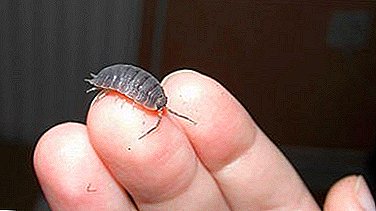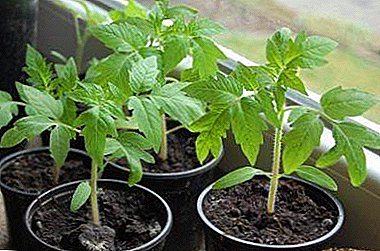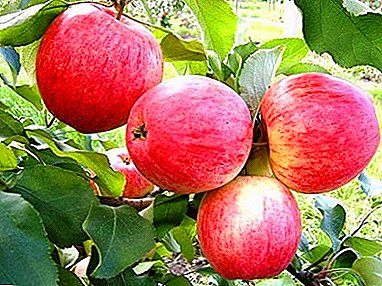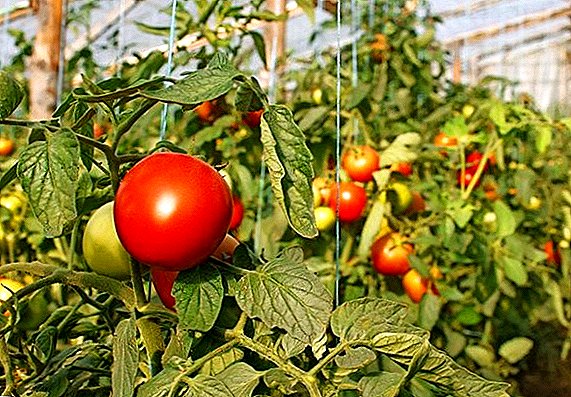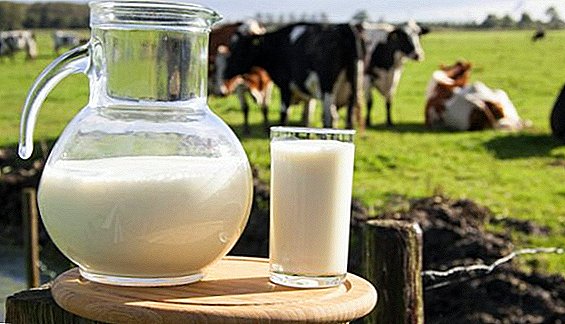 By purchasing a dairy cow for its own farm, the farmer hopes for high-quality and abundant milk yield, bringing in his family an additional element of healthy nutrition and considerable profit. But in order for milk production to be harmonious and constant, it is important to draw attention to some interesting nuances of this process.
By purchasing a dairy cow for its own farm, the farmer hopes for high-quality and abundant milk yield, bringing in his family an additional element of healthy nutrition and considerable profit. But in order for milk production to be harmonious and constant, it is important to draw attention to some interesting nuances of this process.
Cow's milk
Like all mammals, cow's milk is naturally intended solely for feeding offspring. When a signal is received about the need to provide the calf with food, the body of the female cow starts up complex processes that are controlled by the hormone prolactin.
It depends on it the main production of colostrum, and then full-fledged milk. After completion of feeding, a person continues to cow’s lactation, extracting the product from the udder using manual milking or special devices.
Did you know? Every year in early June, World Milk Day is celebrated, which has been celebrated in many countries for 17 years now. Dairy festivals taking place on a holiday urge people to consume dairy products more often, making their diet healthy and full. On city streets, mass tastings from different manufacturers and funny joky contests are held, having won which, a person can go on an exciting excursion to a dairy plant or milk a cow on the farm on their own.
Cow's milk is the most popular and occupies the largest part of all types of milk produced in the livestock industry of world agriculture. 
The nutritional product consists of water, proteins, fats, carbohydrates, ash substances, vitamins and minerals that are useful not only for calves, but also for people of all ages:
- strengthens the nervous system and is involved in the blood;
- lowers cholesterol;
- participates in metabolic processes;
- adjusts the gastrointestinal tract, reduces acidity, helps to cope with gastritis and mild ulcers, regenerates the gastric mucosa;
- due to the large amount of calcium improves the functioning of the musculoskeletal system, has a beneficial effect on the correct growth of the children's skeleton;
- increases the elasticity of blood vessels, prevents the development of heart disease;
- the bactericidal properties of the product help the human body to quickly cope with a cold, the overall immunity is strengthened.
We recommend reading about what is useful and harmful cow's milk.
When begins to give
The first milk that a person can receive by milk production appears in a cow after calving.
In order to carry out the procedure without any problems, you need to perform several important steps:
- An hour after calving, the baby should be allowed to go to the mother's udder so that he would first divide it. For a cow, it will not be as painful as from the first manual milking;
- The first colostrum is for the calf a real fount of vital nutrients, as well as a guarantee of health. Unless wean him sharply from his mother, in the future he will also be distinguished by high productivity;
- The nearby calf contributes to the rapid stress relief of the cow, and also significantly affects her behavior during the first milk yield.
 After the young are removed from the mother, the lactation process can fully continue until the next pregnancy and calving. As a rule, after the secondary lactation period and the subsequent, the female's productivity increases significantly, the quantity and quality of milk yield increases, reaching its peak by 2-5 calves.
After the young are removed from the mother, the lactation process can fully continue until the next pregnancy and calving. As a rule, after the secondary lactation period and the subsequent, the female's productivity increases significantly, the quantity and quality of milk yield increases, reaching its peak by 2-5 calves.Important! Milking in the first week must be done manually. Machine milking can be too painful for a sensitive udder, and the animal will react extremely aggressively to the procedure.After these periods, the cow's body no longer copes well with nutrient replenishment, so its productivity gradually begins to decline.
On average, provided that the female will fertilize annually, the total duration of lactation will be about 5-7 years (depending on a number of individual characteristics of the cow's body). Each period lasts no more than 320 days, and dead wood lasts approximately 1.5-2 months.
How much gives
Average milk yield of dairy cows on farms in Russia, Ukraine and nearby countries are:
- 12-20 liters per day;
- 5 thousand liters per year.

Also the seasons are strongly influenced by the seasons:
- in summertime, the cow's productivity becomes much higher due to a good forage base - numerous vegetable feed, fresh and juicy grass, regular walking in the open air;
- in winter, milk yield becomes poorer only due to impending labor. However, if calving falls on other dates, and the diet is balanced and enriched with high-quality food (hay, concentrates, root crops, succulent fodder, silage) and plenty of water, the cow will give milk in much the same way as in summer.
What determines the productivity
The productivity of cattle is determined by many factors:
- age and weight of the animal;
- individual features of the body;
- proper diet (benefit and calorie food);
- the health of the cow (timely vaccination, the absence of worms);
- compliance with the rules of milking (minimum daily yield - at least 4 liters);
Important! Experienced farmers say that productivity largely depends on the number of daily milk yields. There must be at least three of them. Also, timely separation prevents stagnation, and as a result, such a dangerous disease as purulent mastitis.
- time of year;
- breed (dairy cows are most suitable for productive milking).

Breeds of dairy cows
Thanks to the active breeding work of world and domestic livestock producers, several highly dairy cow breeds can be noted at once. The most popular are:
It will be useful for you to read about what it depends on and how to determine the density and fat content of milk, as well as to find out why milk from a cow becomes bitter.
Golshtinka
Holstein breed was bred in North America. This variety of cattle is considered the most productive in the world. On the day one individual is able to give from 20 to 40 liters of milk, in some cases the figure can reach about 60 liters. For the year, such a cow provides no problems with a household for 7-8 thousand products. 
Red steppe
Red-steppe cows appeared as a result of the work of Russian breeders. The variety is widespread in the Krasnodar Territory and the Southern Urals, as well as in Ukraine, where it adapts perfectly to the hottest weather conditions. The red steppe is distinguished by excellent health and unpretentious care, the number of milk yields per day is 15-30 liters of milk. 
Yaroslavskaya
High-dairy breed, which by productivity can be compared with Holstein. The maximum yield of the Yaroslavl breed, with proper care, varies from 20 to 40 liters per day. The advantages of the variety can also include unpretentiousness to the conditions of detention and good adaptation to the climatic conditions of the middle zone. 
Jersey
Productivity: 20-30 liters of milk per day, 7-8 thousand per year. The Jersey breed got its name from the place where it was bred - the small town of Jersey, located between England and France. A distinctive feature of these cows is a small height, the height at the withers of an adult individual hardly reaches 1.5 meters. 
Black and motley
Cattle of this breed are mainly distributed in the European part of Russia.
Read more about the black-motley breed of cows.The cow gives a good daily milk yield (about 30 liters), is not particularly demanding to the conditions of detention and is well acclimatized in various parts of the country.

Frequently asked Questions
Many novice farmers often ask questions regarding dairy production and the overall cow. Consider the most common.
Does a cow give milk without a calf?
As noted above, a cow is considered to be dairy-free until first calving. Her first and subsequent divisions occur after the birth of offspring, last about 10 months and end with a new pregnancy.
What is the name of a cow that does not give milk?
The female, not bringing milk, is barren, in the people such animals are called "yalovye."
Find out what causes and treatments for infertility in a cow.
Causes of trouble can serve as:
- various genital diseases (congenital or acquired);
- underfeeding or over feeding of cattle;
- improper conditions of detention (too much moisture in the barn, too low temperature, cold drafts, lack of full-fledged walking).
 To solve the problem of infertility is quite possible. Initially, you should try to correct the food and care, contact the veterinarian to identify pathology and then prepare and try to artificially insect a yellow cow with a special method. If the above manipulations do not work, the animal is usually prepared for slaughter.
To solve the problem of infertility is quite possible. Initially, you should try to correct the food and care, contact the veterinarian to identify pathology and then prepare and try to artificially insect a yellow cow with a special method. If the above manipulations do not work, the animal is usually prepared for slaughter.Did you know? Cow's milk can be used not only as food or drink: they can easily remove fresh ink stains, the product enhances the glitter of gold-plated frames and mirrors, refreshes the appearance of the keys, if you add a little product to the blue ink when washing white curtains, they will look even better.
In good, conscientiously created conditions, any cow can live up to 10 years, but how much milk it will give for all its lactation periods will depend on the particular breed, good nutrition and care.
Reviews from the network



